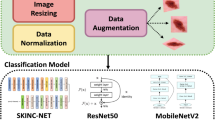Abstract
Skin cancer is one of the worst diseases noticed in humankind. It beholds some types, which even experts find challenging to categorize. In recent times, neural network-based automated systems have been entitled to perform this difficult task for their amazing ability of pattern recognition. However, the challenge remains due to the requirement for high-quality images and thus the necessity of highly configured resources. In this research manuscript, the authors have addressed these issues. They pushed the boundary of neural networks by utilizing a low-resolution (80 × 80, 64 × 64, and 32 × 32 pixels), highly imbalanced, grayscale HAM10000 skin cancer dataset into several pre-trained network architectures (VGG16, DenseNet169, DenseNet161, and ResNet50) that have been successfully used for a similar purpose with a high-resolution, augmented RGB HAM10000 skin cancer image dataset. The image resolution of the original HAM10000 dataset is 800 × 600 pixels. The highest achieved performance for 80 × 80, 64 × 64, and 32 × 32 pixel images were 80.46%, 78.56%, and 74.15%, respectively. All of these results were accomplished from the ImageNet pre-trained VGG16 model. The second-best model in terms of transfer learning was DenseNet169. The performances demonstrate that even within these severe circumstances, neural network-based transfer learning holds promising possibilities.
Access this chapter
Tax calculation will be finalised at checkout
Purchases are for personal use only
Similar content being viewed by others
References
Moldovan, D.: Transfer learning based method for two-step skin cancer images classification. In: 2019 E-Health and Bioengineering Conference (EHB), pp. 1–4. IEEE (2019)
Nugroho, A.A., Slamet, I., Sugiyanto: Skins cancer identification system of HAMl0000 skin cancer dataset using convolutional neural network. In: AIP Conference Proceedings, vol. 2202, no. 1, p. 020039. AIP Publishing LLC (2019)
Garg, R., Maheshwari, S., Shukla, A.: Decision support system for detection and classification of skin cancer using CNN. arXiv preprint arXiv:1912.03798 (2019)
Khan, M.A., Younus Javed, M., Sharif, M., Saba, T., Rehman, A.: Multi-model deep neural network based features extraction and optimal selection approach for skin lesion classification. In: 2019 International Conference on Computer and Information Sciences (ICCIS), pp. 1–7. IEEE (2019)
Reddy, N.D.: Classification of Dermoscopy Images using Deep Learning. arXiv preprint arXiv:1808.01607 (2018)
Goyal, M., Hassanpour, S., Hoon Yap, M.: Region of interest detection in dermoscopic images for natural data-augmentation. arXiv preprint arXiv:1807.10711 (2018)
Sae-Lim, W., Wettayaprasit, W., Aiyarak, P.: Convolutional neural networks using MobileNet for skin lesion classification. In: 2019 16th International Joint Conference on Computer Science and Software Engineering (JCSSE), pp. 242–247. IEEE (2019)
Çevik, E., Zengin, K.: Classification of skin lesions in Dermatoscopic images with deep convolution network. Avrupa Bilim ve Teknoloji Dergisi, pp. 309–318 (2019)
Tschandl, P., Sinz, C., Kittler, H.: Domain-specific classification-pretrained fully convolutional network encoders for skin lesion segmentation. Comput. Biol. Med. 104, 111–116 (2019)
Nahid, A.-Al, Ali Mehrabi, M., Kong, Y.: Histopathological breast cancer image classification by deep neural network techniques guided by local clustering. BioMed Res. Int. 2018 (2018)
Manoharan, S.: Improved version of graph-cut algorithm for CT images of lung cancer with clinical property condition. J. Artif. Intell. 2(04), 201–206 (2020)
Vijayakumar, T.: Neural network analysis for tumor investigation and cancer prediction. J. Electron. 1(02), 89–98 (2019)
Nahid, A.-Al, Ali, F.B., Kong, Y.: Histopathological breast-image classification with image enhancement by convolutional neural network. In: 2017 20th International Conference of Computer and Information Technology (ICCIT), pp. 1–6. IEEE (2017)
Deniz, E., Şengür, A., Kadiroğlu, Z., Guo, Y., Bajaj, V., Budak, Ü.: Transfer learning based histopathologic image classification for breast cancer detection. Health Inf. Sci. Syst. 6(1), 18 (2018)
Tschandl, P., Rosendahl, C., Kittler, H.: The HAM10000 dataset, a large collection of multi-source dermatoscopic images of common pigmented skin lesions. Sci. Data 5, (2018)
Zaballos, P., Daufí, C., Puig, S., Argenziano, G., Moreno-Ramírez, D., Cabo, H., Marghoob, A.A., Llambrich, A., Zalaudek, I., Malvehy, J.: Dermoscopy of solitary angiokeratomas: a morphological study. Arch. Dermatol. 143(3), 318–325 (2007)
Zaballos, P., Carulla, M., Ozdemir, F., Zalaudek, I., Bañuls, J., Llambrich, A., Puig, S., Argenziano, G., Malvehy, J.: Dermoscopy of pyogenic granuloma: a morphological study. Br. J. Dermatol. 163(6), 1229–1237 (2010)
Orenstein, E.C., Beijbom, O.: Transfer learning and deep feature extraction for planktonic image data sets. In: 2017 IEEE Winter Conference on Applications of Computer Vision (WACV), pp. 1082–1088. IEEE (2017)
He, K., Zhang, X., Ren, S., Sun, J.: Deep residual learning for image recognition. In: Proceedings of the IEEE Conference on Computer Vision and Pattern Recognition, pp. 770–778 (2016)
Simonyan, K., Zisserman, A.: Very deep convolutional networks for large-scale image recognition. arXiv preprint arXiv:1409.1556 (2014)
Huang, G., Liu, Z., Van Der Maaten, L., Weinberger, K.Q.: Densely connected convolutional networks. In: Proceedings of the IEEE Conference on Computer Vision and Pattern Recognition, pp. 4700–4708, 2017
Mobiny, A., Singh, A., Van Nguyen, H.: Risk-aware machine learning classifier for skin lesion diagnosis. J. Clin. Med. 8(8), 1241 (2019)
Gessert, N., Sentker, T., Madesta, F., Schmitz, R., Kniep, H., Baltruschat, I., Werner, R., Schlaefer, A.: Skin lesion diagnosis using ensembles, unscaled multi-crop evaluation and loss weighting. arXiv preprint arXiv:1808.01694 (2018)
Author information
Authors and Affiliations
Corresponding author
Editor information
Editors and Affiliations
Rights and permissions
Copyright information
© 2022 The Author(s), under exclusive license to Springer Nature Singapore Pte Ltd.
About this paper
Cite this paper
Khan, M.D.R.H., Uddin, A.H., Nahid, AA., Bairagi, A.K. (2022). Skin Cancer Detection from Low-Resolution Images Using Transfer Learning. In: Raj, J.S., Palanisamy, R., Perikos, I., Shi, Y. (eds) Intelligent Sustainable Systems. Lecture Notes in Networks and Systems, vol 213. Springer, Singapore. https://doi.org/10.1007/978-981-16-2422-3_26
Download citation
DOI: https://doi.org/10.1007/978-981-16-2422-3_26
Published:
Publisher Name: Springer, Singapore
Print ISBN: 978-981-16-2421-6
Online ISBN: 978-981-16-2422-3
eBook Packages: Intelligent Technologies and RoboticsIntelligent Technologies and Robotics (R0)




